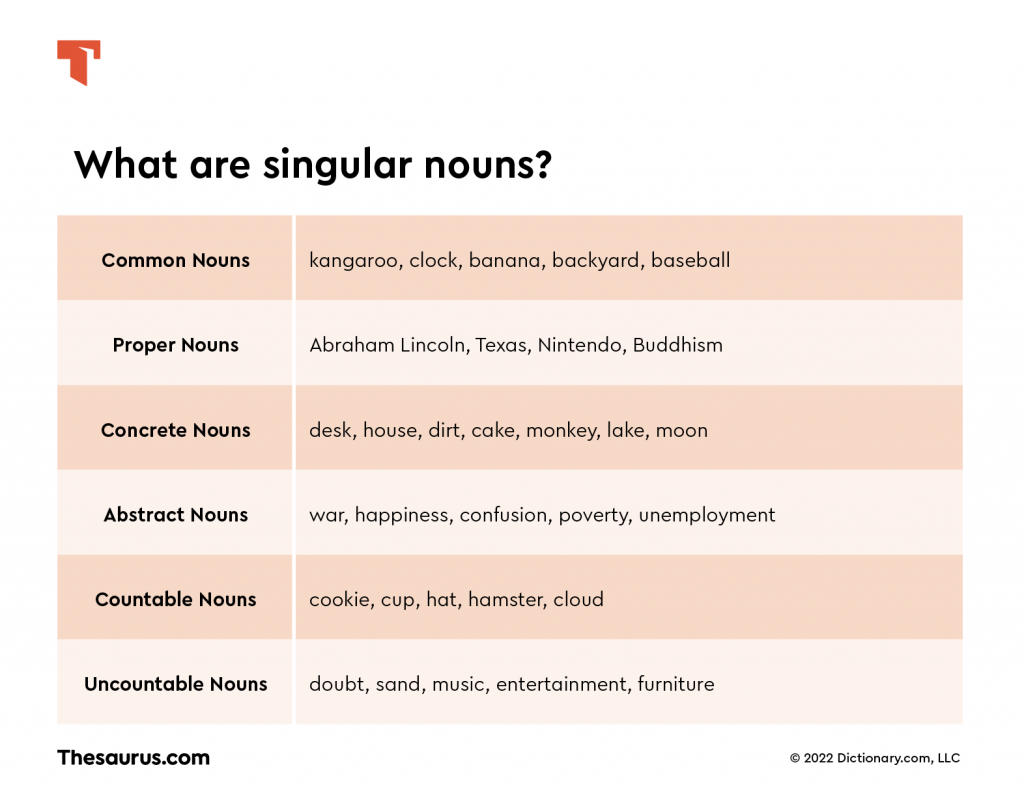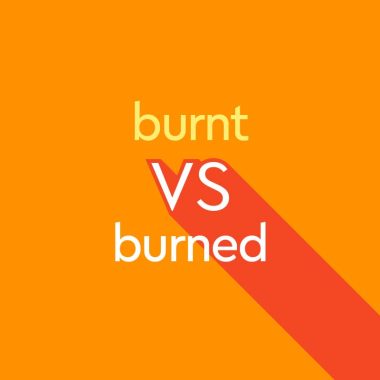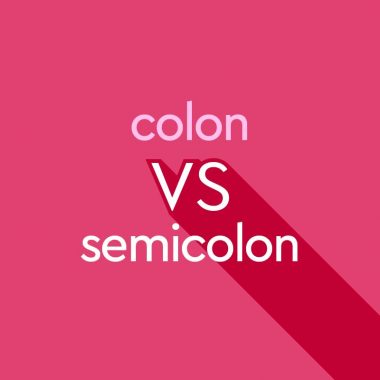 Nouns refer to the many people, places, and things around us. There are many different types of nouns that we use when talking about everything we see or experience. Sometimes, we are talking about one thing. For example, you may have only one pet, one sister, one house, one last slice of pizza, or one idea for a funny knock-knock joke. One is the loneliest number, so let’s try to cheer it up by introducing the term for the type of noun we use to refer to single objects: the singular noun.
Nouns refer to the many people, places, and things around us. There are many different types of nouns that we use when talking about everything we see or experience. Sometimes, we are talking about one thing. For example, you may have only one pet, one sister, one house, one last slice of pizza, or one idea for a funny knock-knock joke. One is the loneliest number, so let’s try to cheer it up by introducing the term for the type of noun we use to refer to single objects: the singular noun.

[article-nav-item jump_link="What's A Singular Noun?"]What is a singular noun?[/article-nav-item]
The word singular, when used in grammar, means “noting or pertaining to a member of the category of number found in many languages that indicates that a word form has one referent or denotes one person, place, thing, or instance.” A singular noun is a noun that refers to one, and only one, object or person. For example, the word girl is a singular noun but the word girls is not a singular noun because it refers to more than one person. Girls is a plural noun.
While singular nouns are usually simple to understand, sometimes things can get tricky. A collective noun, for example, is a singular noun that refers to a group of people or things as a single unit. Words like team, family, and pile are collective nouns. Even though these words refer to multiple people or things, they are still singular nouns because they refer to a single, distinct unit.
Also, some English words like to be difficult and sometimes function as singular nouns. Words like data, fish, and measles may or may not be singular nouns, so be careful! Don’t be surprised if you see some people use these words with a plural verb as in The data are showing a growth in sales or My fish swim really fast. Names and titles also like to be sneaky, so you will need to carefully use nouns like Bahamas and Star Wars. (Countries can be singular or plural depending on the sentence.)
[article-callout-link href="https://www.thesaurus.com/e/grammar/noun/"]Who knew nouns could be so complicated? It might help to visit this review of what a noun can be in more detail.[/article-callout-link]
[article-nav-item jump_link="Examples"]Singular noun examples[/article-nav-item]
Of all of the different types of nouns we use, singular nouns are relatively easy to use. There aren’t any special capitalization or punctuation rules you need to remember when using them. The one thing you must remember is that singular nouns use singular verbs such as is, was, or does. Simply remember that a singular noun is a noun that refers to one person, place, or thing. Let’s take a look at examples of singular nouns.
People and animals
Singular nouns are used to refer to one person or one animal. Both generic and specific people and animals can be referred to with singular nouns.
- People: man, woman, firefighter, waiter, hero, Batman, Queen Elsa
- Animals: dog, cat, bird, bug, lion, tiger, bear, Mickey Mouse, Koko the Gorilla
Places
Just as before, we use singular nouns to refer to one place.
- beach, city, neighborhood, town, island, country, Mexico, France, China, Australia
Things
You can use singular nouns to refer to a lot of stuff you experience with your five senses.
- chair, computer, apple, cinnamon, trash, hat, wind, rain, Google, Twitter, Amazon
Ideas
We also use singular nouns to refer to ideas, emotions, philosophies, concepts, and other intangible things you can’t detect with your five senses.
- hunger, sadness, time, disease, government, religion, peace, science, Friday, October
List of singular nouns
Many of the other types of nouns can also be singular nouns. Let’s look at some examples of different types of nouns used as singular nouns.
Common nouns: kangaroo, clock, banana, backyard, baseball, toy
Proper nouns: Abraham Lincoln, Texas, Nintendo, Buddhism
Concrete nouns: desk, house, dirt, cake, monkey, lake, moon
Abstract nouns: war, happiness, confusion, poverty, unemployment
Countable nouns: cookie, cup, hat, hamster, cloud
Uncountable nouns: doubt, sand, music, entertainment, furniture

[article-nav-item jump_link="Singular Vs. Plural Nouns"]The difference between singular and plural nouns[/article-nav-item]
To recap, a singular noun refers to one person, place, or thing. The type of noun that refers to more than one person, place, or thing is known as a plural noun. Singular nouns always use singular verbs (such as is, was, and walks) while plural nouns use plural verbs (such as are, were, and walk). Only singular nouns can use the articles a and an.
Plural nouns can be tricky to tell apart from singular nouns. Many plural nouns are created by simply adding the letter S to a singular noun as in the words cats, hamburgers, or ideas. However, many plural nouns do not follow this rule, so you need to keep an eye out. Always remember the rule that a singular noun is a noun that only refers to one person, place, or thing. Here are examples of the different ways that we use singular and plural nouns:
- A lady (singular noun) bought a dress (singular noun) from the store (singular noun).
- My brother (singular noun) collects stamps (plural noun).
- Math (singular noun) gives me headaches (plural noun).
- The shark (singular noun) had sharp teeth (plural noun).
- Chris didn’t meet the required criteria (plural noun!) for being a dancer (singular noun).
- I caught a really big fish (singular noun).
- Octopuses (plural noun) sometimes eat many fish (plural noun).
[article-nav-item jump_link="Grammar Coach Helps!"]All the nouns, none of the errors[/article-nav-item]
Did you know that singular also means “extraordinary, remarkable”? And you too can be a singular writer with the help of Thesaurus.com’s Grammar Coach™. This writing tool uses machine learning technology uniquely designed to catch grammar and spelling errors. Its Synonym Swap will find the best nouns, adjectives, and more to help say what you really mean, guiding you toward clearer, stronger, writing.
Whether you’re writing about a person, place, or thing, perfect grammar has never been easier!
[gravityform id="3" title="true" description="true"]













